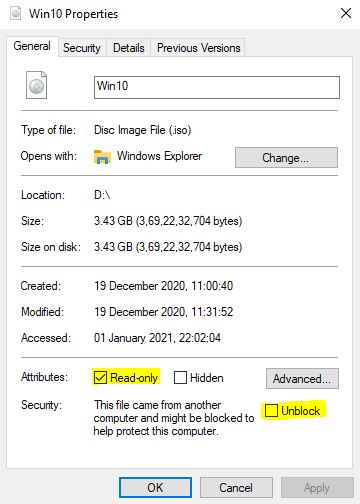
- #VHD SORRY THERE WAS A PROBLEM MOUNTING THE FILE INSTALL#
- #VHD SORRY THERE WAS A PROBLEM MOUNTING THE FILE ISO#
- #VHD SORRY THERE WAS A PROBLEM MOUNTING THE FILE WINDOWS 7#
#VHD SORRY THERE WAS A PROBLEM MOUNTING THE FILE INSTALL#
The step where I install an OS onto my VHD takes too long, so I'd like a prepared VHD that's already to be started for the first time, kind of like when you buy a machine from Dell or whoever and you get that nice "starting your computer, detecting drivers" action on first boot. I'm always trying crazy new Daily Builds of big stuff that takes a while to be installed. However, this is STILL not convenient enough for me. If you want to install your OS (Windows Server 2008 and Win 7 Enterprise or Ultimate are the only ones supported) then you just install away. You can create a blank VHD, set it up in your boot menu with BCDEdit ( details and walkthrough here and a video demo here) and then just boot off your VHD. VHD as a disk format is built into the Operating System (although, strangely, you can't mount ISOs.).
#VHD SORRY THERE WAS A PROBLEM MOUNTING THE FILE WINDOWS 7#
Making a VHD is easy with Windows 7 since you can create and mount/attach VHDs in the standard tools. Also is awesome on a laptop if you have the HD space. Your OS runs on the hardware directly, except your disk, which is virtualized and runs inside a single file. You get Undo support for your disks.Įverything is virtualized, so you're taking a perf hit on pretty much everything. Your OS's are completely separate from each other and can't hurt one other. Or you can have them all share the same disk, which is dangerous. You have to partition which means disks of fixed size. This isn't Virtual Machines, to be clear, and it's not Dual Booting.

The new layout will be as follows.I'm loving the Windows 7 "Boot to VHD" lifestyle.
#VHD SORRY THERE WAS A PROBLEM MOUNTING THE FILE ISO#
Now when you mount the ISO image, it will be auto assigned to drive E without generating any errors. However, the drive continues to function.Īfter you eject the ISO drive F, reassign the USB drive to drive F. It causes the error that is mentioned in the "Symptoms" section. In this layout, the ISO image is auto assigned to drive F when it is mounted. The file might not behave correctly if it has an assigned drive that follows other drives.įor example, consider the following layout. Then, reassign the drive letters in such a manner that you leave a lower drive letter available to mount the ISO image. If you have a flash media reader or any removable media, try to eject the removable media. This process should remove the sparse attribute and enable the file to be mounted. Resolution 1Ĭopy the ISO file to a new file by saving it to a different folder or giving it a different name. To resolve this problem, use one of the following methods. Run the following Windows PowerShell command: (get-item c:\test\mydisk.iso).attributesĬheck for the word "SparseFile" in the command output to indicate a sparse file.


Sorry there was a problem mounting the file iso file in Windows Explorer to try to mount the ISO image, the operation fails and you receive the following error message: Although you receive the error message, the ISO image is mounted successfully in most cases.


 0 kommentar(er)
0 kommentar(er)
